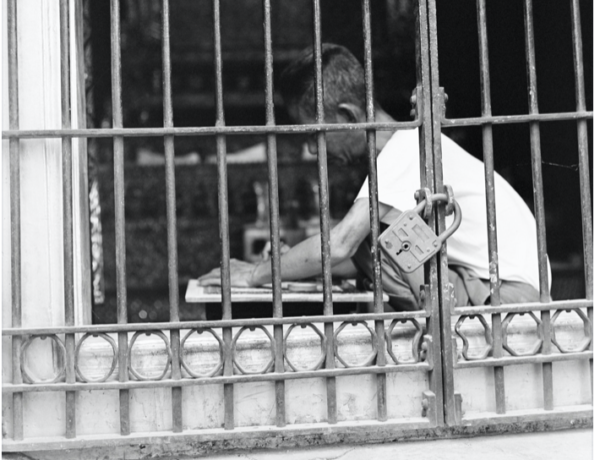From Merle Haggard and Ozzy Osbourne, Meek Mill and T.I. (all former prisoners) to the music and music artists echoing within prison walls, there is an underlying score playing throughout prisons, much like that in the background of a movie. Whether a rap meant to let everyone know you’re not dead yet or a song written in a fever-dream while lying in a prison cell, songs, raps, beats, and occasional instruments reverberate throughout prisons across the country every single day.
ROCKING OUT
It’s night as I walk to the music room, a converted storage room in the prison’s multipurpose building. I give my pass to the officer and go down the hall. Over fifty feet away, I can already hear the muffled sounds of our drummer keeping a beat through the cinderblocks. As I get closer, I start to hear the chugging of our lead guitarist’s electric guitar. Opening the door, I’m blasted by concert-level acoustics for a moment, proof that the noise-dampening carpet squares glued to the walls really do work, and I pick up the only bass guitar from the five cheap stringed instruments hanging on hooks from the wall.
I took a few guitar lessons as a kid, but music wasn’t important in my family or to anyone I knew. Years later, in prison, music became a way of mental escape for me. At one point, a cellmate of mine got a guitar, and he let me play it. I quickly learned a handful of cover songs I liked, though I rarely played in front of others.
THE SOUNDTRACK OF LIFE INSIDE
In the 1990s, portable radios with speakers could be purchased in Michigan prisons and prisons across the country. Rap, R&B, jazz, and rock blare through the remaining ones today in cells and on the yard. Those old Sony Walkman cassette players were the only other source of music available inside until 2010, long after cassette tapes disappeared from stores and only specialty mail-order companies (approved by the prison) sold them. CDs were never allowed in because they were too sharp and pointed if broken.
The availability of music changed a lot when a prison supply company got a contract to sell small, cheap mp3 players to prisoners for a huge markup. Despite gripes about the costs and quality, a whole new world of music became available. Some musical artists are so popular in prisons all over the United States that their new mansion could have been fully financed by convicts alone.
PRISON CONCERTS
Very few prison bands create their own music. Our prison rock band, “Collusion,” was a cover band. Being a cover band provided us specific goals to work towards together.
A general rule about prison bands is that at least one band member will be transferred out of the prison (and therefore the band) before everyone learns to collaborate well enough to write new songs as a group. With no way to record the band’s songs (usually), creating new songs can be an experiment in aggravation.
We were the only rock band at the time, though there were R&B bands, jazz bands, Christian bands (most of the best music made in prison comes from the religious bands), and a rap duo that created their own beats on the electric keyboard.
I pick up the bass guitar and plug it into the amp. Soon, we’re all jamming. We plan to perform a concert before the whole prison in a couple of months, and we’re doing a “rock history” theme, with one song each from the 1960s, ’70s, ’80s, ’90s, ’00s, and ’10s. I feel the music vibrating in my bones as Rush’s “Tom Sawyer” gives way to Pearl Jam’s “Alive” (both songs that resonate particularly well with men inside).
Prison concerts have a long history, the most famous of which were Johnny Cash’s concerts in Folsom Prison, which gave him some serious street cred, and Elvis Presley’s fictional ones in “Jailhouse Rock.” Today, some prisons (including this one) still get visited by outside performers, often religious-based artists.
Most concerts, however, are put on by the prisoners themselves. And the prison goes wild for them. Men in prison uniforms surround the improvised stage set up on the basketball court or in the gym or chapel. No one in the band gets paid, though prison-currency like Ramen noodles and soaps occasionally get thrown on stage (also, THANK YOU to the one audience member who threw those pair of tighty-whitey underwear on stage that one time). People show up sober or drunk on fermented orange juice, sometimes high. Fights have broken out. The ambience is fully alive.
The best feeling, and the one that makes the effort worthwhile, is when the audience full of rival factions and races and gangs, who otherwise want to shank each other, instead all break out in unison, singing and clapping along with our music. In those moments, it feels like we did something that made things better. Even if only for a moment.
CREATING MUSIC
Much of the real creativity takes place on the prison yard, in the cellblocks, or in the religious groups. It happens on the outdoor benches where an elderly guitar player teaches—to a kid just learning—a song he wrote after a half-century of being incarcerated. It happens when a former house-band member for Motown instructs another prisoner on the keyboard for the low fee of a $5.00 bag of instant coffee a month. It happens in prison cells where one bunkie teaches another guitar scales. It happens when incarcerated members of the church sync their sound to praise God. Here, music is created not specifically about prison but about life itself, the good times and the bad and all the moments between . . . like life spent inside one’s mind or one’s surroundings.
Guitars, flexible roll-up keyboards, harmonicas, and literally anything that people can drum their hands on, keep the rhythm. Sometimes beautiful and sometimes not, these songs tell stories about longings and desire, and about the deepest parts of the soul. They are good, bad, hopeful and sad, loud and meek.
HEAR SOME MUSIC
I had the immense privilege of being able to record a few songs I wrote. After nearly dying on my cell floor during the beginning of the pandemic, I spent the next two years recovering while on what was essentially a complete lockdown of the prison system. Stuck in my cell, or in my cellblock, almost all of every single day for years, I learned to improvise and create on my guitar while working on some poetry, combining the two to write a few songs on what I had available. Thanks to Dina Milito, and especially to her son Sean who helped me with this, I was able to record them and make them available to listen to.
(Public prison phones are not conducive to creating good recordings, and my voice suffers from an old throat injury, but it was tremendous fun to try playing in a different way, and the songs come from the heart of someone self-taught after a lifetime in prison.)
KEEP ROCKIN’
To everyone in prison, keep rockin’, and never let the music fade away!





No Comments